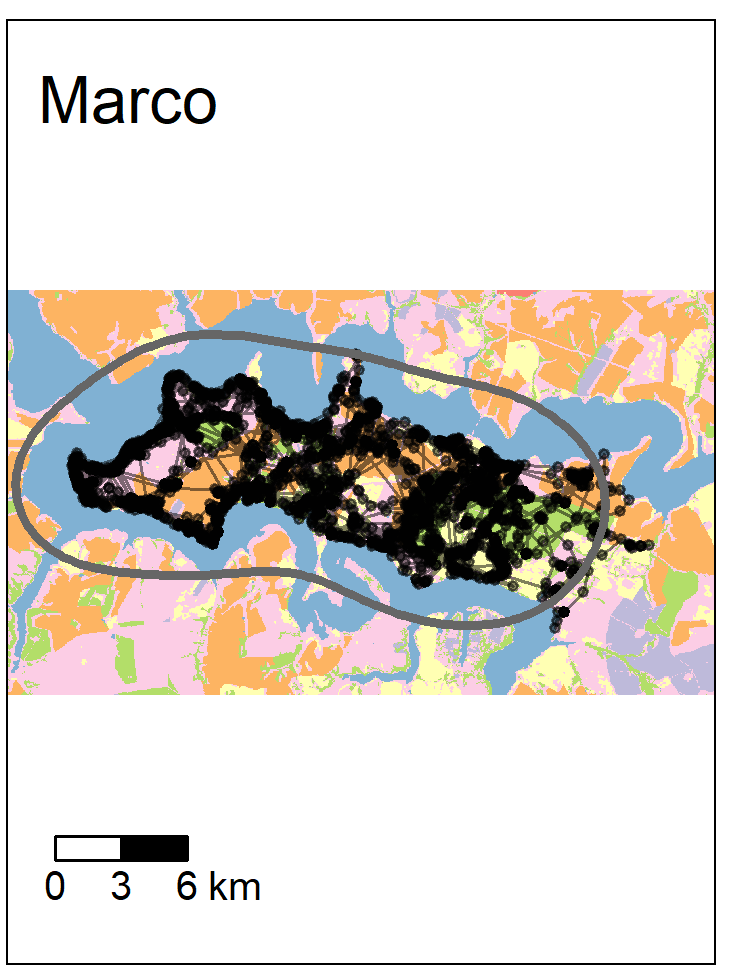home range estimation in the presence of barriers or non-used areas
149 views
Skip to first unread message
Bernardo Santos
Nov 4, 2020, 9:05:08 AM11/4/20
to ctmm...@googlegroups.com
Dear list,
I am fitting ctmm to some
animal trajectories and estimating home range area and movement
parameters within that. The idea is to relate the HR area and these
parameters (speed, autocorrelation times) with mean values of
environmental covariates extracted for each 95% akde isopleth.
However,
in my case several animals are living in the borders of a dam, which
they do not use and do not cross. When I look at the akde polygon it
takes a great part of the dam, even though this area of water is not used for e.g. foraging, mating, conspecific attraction or avoidance (as the classical definitions of home range).
It may be a barrier to movement, and influence habitat selection,
though. Here below there is an example of an individual, and we see the
water comprises a great part of the HR, even though the animal is
restricted to a "peninsula".
This
question could be extended to other kinds of barriers, I guess. How to
deal with home range size calculation and extraction of covariates?
Should I remove the area of the dam (and beyond) to calculate these
quantities?
I know this is not a new a topic
and also arises for other home range estimators, such as traditional
KDEs. There is this study by Benhamou and Cornélis 2010 that accounts
for barriers in KDE, and I found some other approaches, but nothing
related to ctmm and akde. And it seems to me that generally akde's
polygons are larger than other estimators HRs, potentially including
more barriers or other places where movement is restricted or not
possible.
Does anyone has experience on how to deal with these cases?
Best wishes,
Bernardo
Bernardo Niebuhr
Nov 4, 2020, 9:11:35 AM11/4/20
to ctmm R user group
For some reason the image was not sent. Here it is, I hope it is correctly attached now.
Best
Bernardo

Christen Fleming
Nov 4, 2020, 2:02:30 PM11/4/20
to ctmm R user group
Hi Bernardo,
Yeah, KDEs have discontinuity bias where they spill over boundaries and convex hull methods are only ensured to respect convex boundaries (e.g., not winding rivers).
The simplest solution is to mask the CDF. The AKDE's grid coordinates are located in AKDE$r$x and AKDE$r$y and the CDF is in AKDE$CDF. So, you can just loop over the rows (i) and columns (j) of the CDF like
for(i in 1:nrow(AKDE$CDF)) {
for(j in 1:ncol(AKDE$CDF)) {
if( c(AKDE$r$x[i],AKDE$r$y[j]) is an inaccessible location )
{ AKDE$CDF[i,j] <- 1 }
}}
Then when you calculate the home range areas of the AKDE, those regions will not be included.
A slightly better solution is to mask the individual kernels, as Benhamou and Cornélis sugges, but I haven't coded this up yet.
Even better is to to also mask at the autocorrelation model fitting stage, with a non-linear filter. This is all some time out.
Best,
Chris
Bernardo Santos
Nov 5, 2020, 9:35:22 AM11/5/20
to ctmm R user group, Christen Fleming
Thanks for your answer, Chris.
I guess I'll try the first option for now. If I am mainly interested on the isopleths, would that first solution in any way differ from croping the inaccessible area from the akde isopleth polygon?
(or, on the contrary, keeping only the accessible parts of the polygon)
Best
B
--
You received this message because you are subscribed to the Google Groups "ctmm R user group" group.
To unsubscribe from this group and stop receiving emails from it, send an email to ctmm-user+...@googlegroups.com.
To view this discussion on the web visit https://groups.google.com/d/msgid/ctmm-user/ae4df02e-57a6-4312-b71f-1699201a0c00o%40googlegroups.com.
You received this message because you are subscribed to the Google Groups "ctmm R user group" group.
To unsubscribe from this group and stop receiving emails from it, send an email to ctmm-user+...@googlegroups.com.
To view this discussion on the web visit https://groups.google.com/d/msgid/ctmm-user/ae4df02e-57a6-4312-b71f-1699201a0c00o%40googlegroups.com.
Christen Fleming
Nov 5, 2020, 10:54:38 AM11/5/20
to ctmm R user group
It's the same thing.
Best,
Chris
To unsubscribe from this group and stop receiving emails from it, send an email to ctmm-user+unsubscribe@googlegroups.com.
Reply all
Reply to author
Forward
0 new messages
